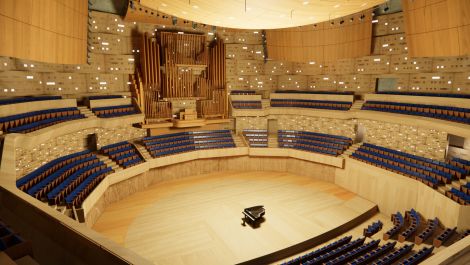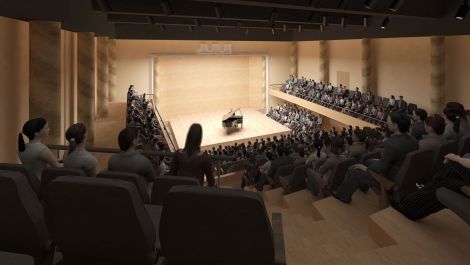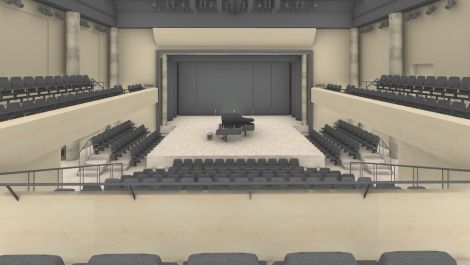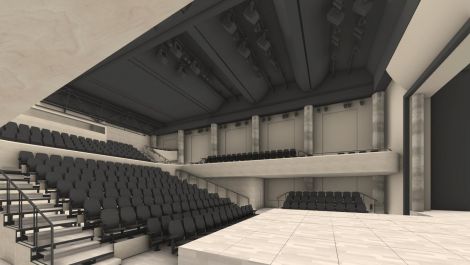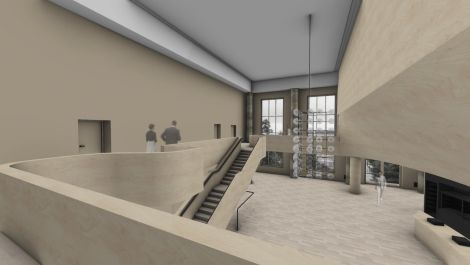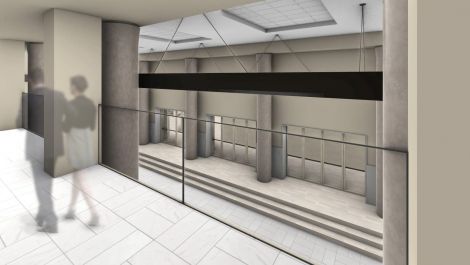Purpose
Open 24/7, almost literally! It is not only music that makes a person alive. What will the new building on the main city artery offer to the people of Ostrava?
Functional Use
The new concert hall, along with the reconstruction of the existing House of Culture, has the potential to become the main cultural center in Ostrava. It will be a public space for the residents of the city and its surroundings. It will house one of the leading Czech symphony orchestras, the Janáček Philharmonic Ostrava. This orchestra has been performing in inadequate spaces for 70 years. The average ticket sales for its events are almost 90% sold out. The House of Culture of the City of Ostrava is the largest cultural center with the highest long-term attendance in Ostrava. Annually, almost 300,000 people visited the center. However, the social hall, theater, cinema, restaurant, and other spaces urgently need renovation after 60 years of existence. The entire project was developed based on a content analysis of the cultural needs of today's Ostrava residents.
The future and use of the entire complex
- Large concert hall with a capacity of 1,300 seats
- Theatre hall with a capacity of 490 seats
- Multifunctional /chamber hall with a capacity of 515 seats
- Education centre with a capacity of 200 seats
- Multifunctional lecture hall with of 120 seats
- Facilities for the 100-member orchestra and for administration of the Janáček Philharmonic Ostrava
- World-class recording studio
- Restaurant, café,lounges, leisure facilities...
Expected attendance of 500,000 people per year.
The grand hall with a capacity of 1,300 seats in the auditorium, arranged in a so-called vineyard, will be divided into smaller sections, and part of the auditorium will also be behind the stage. A sufficiently steep arrangement ensures good visibility and smaller terraces create a feeling of intimacy. The farthest seats should be about 28 meters from the stage. The excellent acoustic properties of the hall are assumed thanks to the cooperation with experts from the Nagata Acoustics studio. A sound reflector should be hung at a height of 15 meters above the stage, which will reflect the sound with an ideal time delay for both musicians and the audience in the immediate vicinity of the stage. Rectangular ceilings improve the acoustics on the stage so that musicians can hear not only themselves but also the others. The Janáček Philharmonic Orchestra will use the hall for daily rehearsals and concerts, which will enable it´s artistic development. The quality of the sound is further enhanced by the maple wood panelling, which is also used for the production of violins. A chamber hall with a capacity of 515 seats will be created in the premises of the existing social hall of the House of Culture of the City of Ostrava. The stages in both halls will be composed of movable panels, which will allow flexible adaptation of the space to the needs of artists, orchestras and other uses of the halls. The halls will thus also become a commercially attractive and sought-after space for organizing various not only musical projects.
In addition to the concert hall, the extension will also provide storage space for larger musical instruments, which must be close to the stage due to more demanding transport. This applies, for example, to pianos, which require a room with constant temperature and humidity, which guarantees a longer service life. The project does bears in mind the visitors needs too. Therefore, there is also a space for a cafe overlooking the park and a lounge for about 40 people.
The space of the existing restaurant will be prepared for a new operator.
The design also envisages the use of the central wing of the cultural house for the changing rooms of the orchestra members, conductors and soloists. There will also be offices, tuning rooms, rehearsal rooms and storerooms for musical instruments. In one of the side parts of the existing building, a recording studio will be created, which, thanks to its parameters, will be the only one of its kind in Moravia and will be used not only for the Philharmonic's internal needs but also for commercial use.
The new Educational Centre with a maximum capacity of 200 people will find its place in the premises of the former Cinema for Demanding Audience. It will be an independent space with its own entrance focusing on music, theatre and art workshops for schools and the general public. It will also be possible to use this space for short-term rentals.
The mission of the present theatre hall, where approximately fifty evening performances and dozens of morning performances for schools took place every year, will be maintained.
The Art Cinema will be transformed into a commercial conference hall with a capacity of up to 120 seats.
The entire project of the reconstruction of the House of Culture of the City of Ostrava is also being prepared. The architects base their designs on the original construction plans and implementation documentation of this listed building by the architect Jaroslav Fragner. The study restores the original form to the spaces related to the Cinema of the Demanding Audience. The aim is the overall renovation of a number of spaces of the House of Culture with respect to the existing valuable materials and details. The material solution is based on the existing used materials, wood panelling and other accents, which give the individual spaces their individuality and unmistakable charm. At the same time, the structure as a whole harmoniously and conceptually integrates both the house of culture as well as the entire project of the new concert hall and the rebuilt chamber hall.
Janáček Philharmonic Ostrava
Janáček Philharmonic Ostrava (JPO) is a successful and sought-after ensemble with which world-class conductors such as Andrey Boreyko, Domingo Hindoyan and Tomáš Netopil regularly collaborate. In the recent past, the orchestra has hosted – whether in Ostrava or on tour – prominent soloists such as cellists Gautier Capuçon and Steven Isserlis, violinists Lisa Batiashvili and Vadim Gluzman, singers Elīna Garanča and Jonas Kaufmann, pianists Jean-Efflam Bavouzet, Boris Giltburg and Simon Trpčeski, and many others. From 2020 to 2024, Vassily Sinaisky served as the Chief conductor and Artistic director. Starting in 2026, this position will be held by Daniel Raiskin, who will take on the role of Principal guest conductor from 2024.
The reputation of the JPO is guaranteed mainly by its hundreds of first-class musicians not only from the Czech Republic but also from abroad. It plays over fifty concerts a year for its home audience in Ostrava. It is regularly invited to perform at both national and international festivals and tours – in recent years it has performed in Tokyo, Seoul, Paris, Berlin and Tallinn, to name a few. The Orchestra has made guest performances in China, Korea, the Baltics, Germany, Spain, Italy, Switzerland and Poland.
The JPO’s repertoire includes, of course, Leoš Janáček, whose name the orchestra proudly carries, Antonín Dvořák and other Czech composers. The JPO’s recordings have been released on many prestigious record labels, and a recent recording of Phidylé for Supraphon even won a BBC Music Magazine Award. The orchestra has composed music for many films and has collaborated with popular Czech musicians such as Aneta Langerova and Vojtech Dyk. The orchestra also focuses on educational cycles for younger audiences and seniors, and on nurturing talented soloists and conductors, who are even given the opportunity to perform with the orchestra in a separate concert series. Since 2020, the JPO has been contributing to the alternative education and professional development of young talented musicians from all over the world with the International Orchestral Academy project.
During the reconstruction of the House of Culture in Ostrava and the addition of the concert hall, the former Vesmír cinema serves as the orchestra’s home venue. However, once completed, the Janáček Philharmonic Ostrava will return to the newly renovated cultural complex and move all its activities there, offering them to audiences in Ostrava and the Moravian-Silesian Region. The new spaces will enable the orchestra to make significant artistic advancements.
The House of Culture Ostrava
The House of Culture of the City of Ostrava (DKMO) is the work of architect Jaroslav Fragner, one of the most prominent representatives of functionalism in our country. From its opening in 1961 until its closure in 2022 due to planned renovations, it was one of the largest and most significant cultural and social institutions in the Moravian--Silesian metropolis. Dozens of agencies, schools, and companies sought collaboration with it, and its programs were attended by nearly 300,000 people annually, making it one of the most visited institutions in Ostrava.
In addition to its regular programming, which included a diverse array of its own theatrical performances, concerts, exhibitions, conferences, seminars, film screenings, children’s and youth programs, balls, and courses, it also served as a venue for Ostrava residents’ leisure activities, a center for physical fitness, and overall health care. The Janáček Philharmonic Orchestra and the Leoš Janáček International Music Festival, highly prestigious cultural institutions, were housed within The House of Culture of the City of Ostrava, where they found not only administrative support but also a venue for a major part of their concert activities in Ostrava.
After more than sixty years of existence, the building, declared a cultural monument in 2004, required renovations coupled with a functional transformation into a complex that meets the current demands of organizers, tenants, and visitors. The new cultural complex will include an extension with a concert hall featuring world-class acoustics.
